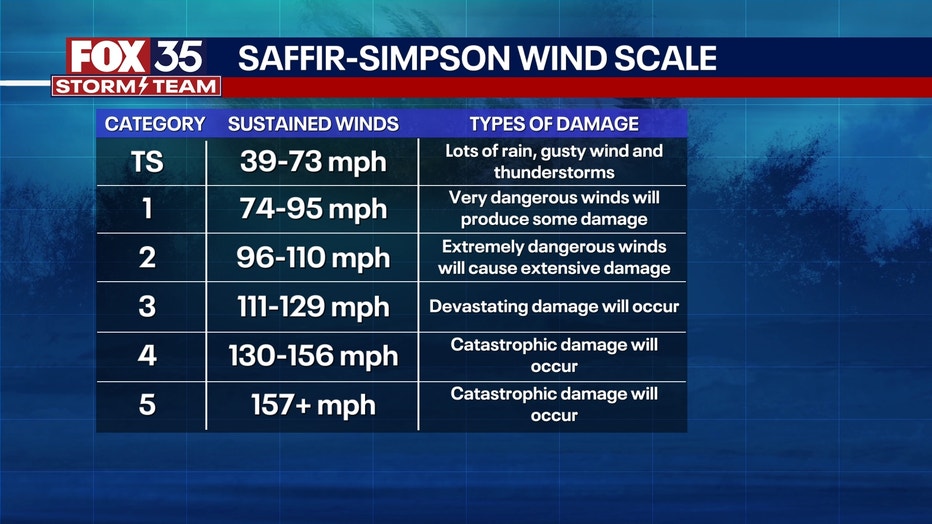Hurricane wind speed categories: Saffir-Simpson Hurricane Wind Scale explained

FOX 35 Special: 2025 Hurricane Season Preview
FOX 35's Tracking the Tropics: 2025 Season Preview looks ahead to the 2025 Hurricane Season, forecasts, and how Floridians can prepare.
When does a tropical depression become a tropical storm? And when does a tropical storm become a hurricane? What's the difference between a Category 1 and a Category 3 hurricane?
It's all about sustained wind speeds within the storm and how strong those winds are, as well as the potential damage to homes, buildings, and life.
The 2025 Atlantic hurricane season began June 1, and runs through Nov. 30. Forecasters are anticipating an above-average season with 13-19 named storms, 6–10 hurricanes, and 3-5 "major" hurricanes.
Saffir-Simpson Hurricane Wind Scale: How hurricanes are rated
Hurricanes are rated on a five-point scale – Category 1 to Category 5, referred to as the Saffir-Simpson Hurricane Wind Scale. A hurricane that is ranked a Category 3, Category 4, or Category 5 storm is considered to be a "major" hurricane.
It's important to note that hurricanes are only categorized by their wind speeds, and not their other destructive properties, such as rainfall, flooding, storm surge, or tornadoes.
- Tropical Storm: A tropical cyclone with sustained winds of 39-73 mph
- Category 1 hurricane: Sustained winds of 74-95 mph
- Category 2 hurricane: Sustained winds of 96-110 mph
- Category 3 hurricane: Sustained winds of 111-129 mph
- Category 4 hurricane: Sustained winds of 130-156 mph
- Category 5 hurricane: Sustained winds of 157 mph or higher

What is a major hurricane?
Any hurricane that is at least a Category 3 hurricane or higher is considered to be a major hurricane, resulting in devastating or catastrophic wind damage.
- Category 3 hurricane: Sustained winds of 111-129 mph
- Category 4 hurricane: Sustained winds of 130-156 mph
- Category 5 hurricane: Sustained winds of 157 mph or higher

Hurricane damage explained: Saffir-Simpson Hurricane Wind Scale
This NOAA animation explains the level of wind damage expected from hurricanes using the Saffir-Simpson Hurricane Wind Scale. Credit: NOAA.
Hurricane wind damage by Category
- Category 1: Some
- Category 2: Extensive
- Category 3: Devastating
- Category 4: Catastrophic
- Category 5: Catastrophic
Who were Herbert Saffir and Robert Simpson?
Herb Saffir and Robert Simpson created the wind scale used to describe hurricanes and their damage impacts. Saffir was a wind engineer and Simpson was a meteorologist and former director of the National Hurricane Center.
Saffir died in 2007 at the age of 90 from surgery complications, according to the Associated Press at the time, citing Saffir’s son.
Simpson died in 2024 at the age of 102, according to an online bio.
The Source: The information in this article comes from NOAA's National Hurricane Center website on the Saffir-Simpson Hurricane Wind Scale. Information on the lives of Herb Saffir and Robert Simpson came from online obituaries, statements, and an Associated Press article.

